Family : Salamandridae

Text © Dr. Edoardo Di Russo

English translation by Mario Beltramini
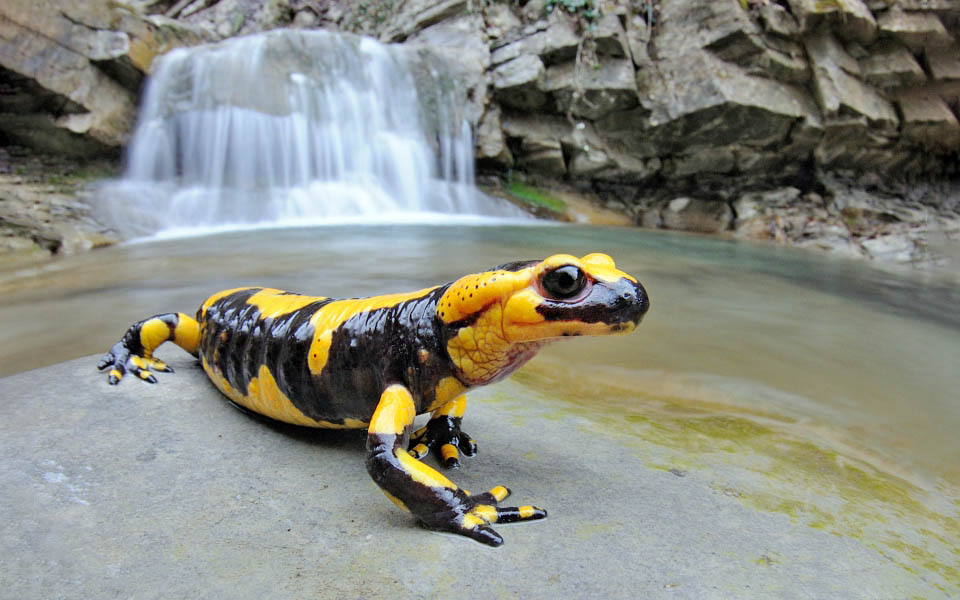
Present in almost all central Europe, the Fire salamander (Salamandra salamandra) reaches even Anatolia and the northern coast of Morocco © Matteo Di Nicola
The Fire salamander or Spotted salamander (Salamandra salamandra (Linnaeus, 1758)) belongs to the class Amphibia, the vertebrates that spend at least a part of their vital cycle in the water world, to the order Caudata, the amphibians with tail, and to the family Salamandridae.
The species is listed in the Appendix III of the Berne Convention of 1979 for the Conservation of European Wildlife and Natural Habitats. The IUCN (International Union for Conservation of Nature) in its Red List records this species under the status “Minimum Risk” (LC – Least Concern), an assessment shared also by the Italian Committee concerning the protection of the species in Italy.
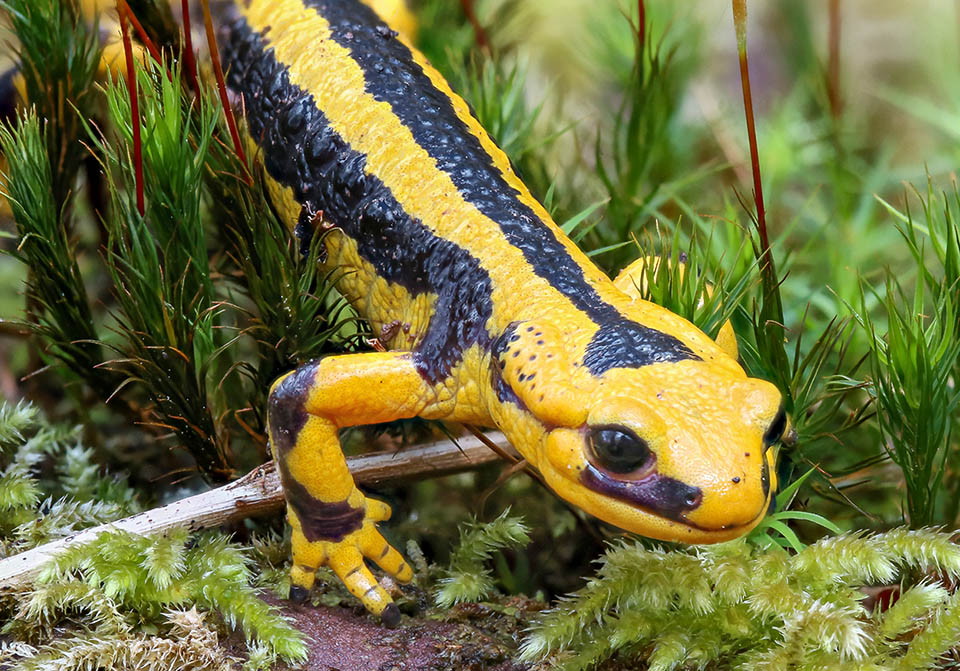
Mainly frequents woods of broadleaved trees with humid litter and presence of water streams © Frank Hendre
The term Salamandra comes from the Latin “salamandra” and from the Greek “σαλαμάνδρα” (salamander). This word has been used for indicating most urodele amphibians.
Zoogeography
The distribution of the Fire salamander sees a range including most of Europe, reaching Anatolia and North Africa.
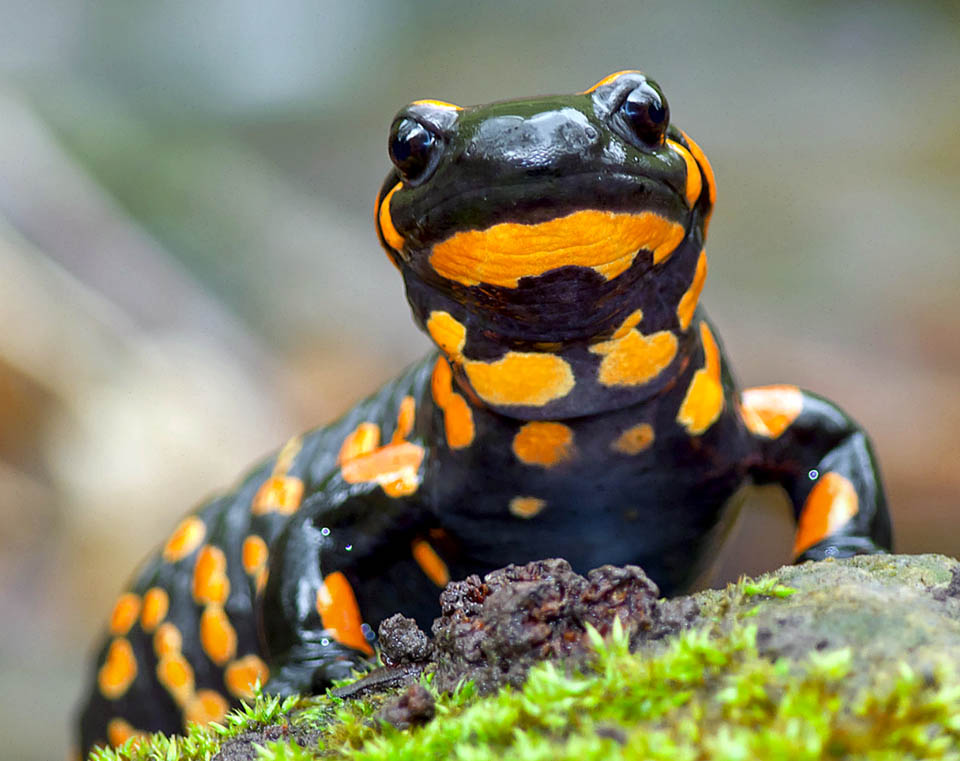
Its livery is a typical example of aposematism, with showy drawings and colours that remind to the predators the presence of poison in the skin © Adam Gor
Its European geographic limits are, west, in Portugal, north, in southern Poland, east, in southern Ukraine and south, in Georgia.
Presently 12 to 17 subspecies of Salamandra salamandra, are recognized, mainly in the Iberian Peninsula, even if their taxonomic validity is still under discussion. To distinguish the different subspecies based only on their morphology at times may result not efficient as commonly occur cases of hybridization and of phenotypic convergence. For a correct identification of the specimen is necessary to know the place of origin and possibly carry out genetic analyses.
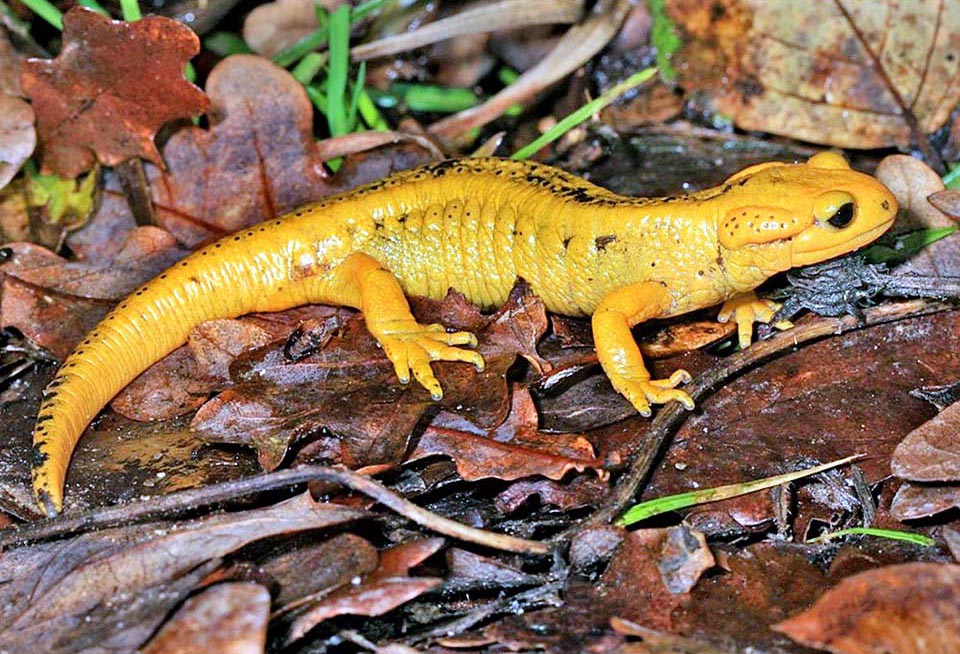
Moreover, it shows an incredible variability of colours among the various subspecies and inside the populations © Alfredo Sánchez-Tójar
Here they are listed in distributional order starting from the western limit in Portugal.
Salamandra salamandra gallaica, that lives in the northern belt of the boundary Spain-Portugal. It is characterized by the presence of black or yellow spots that may recall the shape of a horseshoe or of a comma.
Salamandra salamandra crespoi, endemic to southern Portugal. In particular, we find it in the Serra de Monchique and in the Serra de Grandola. It has been observed also east, towards the boundary with Spain.
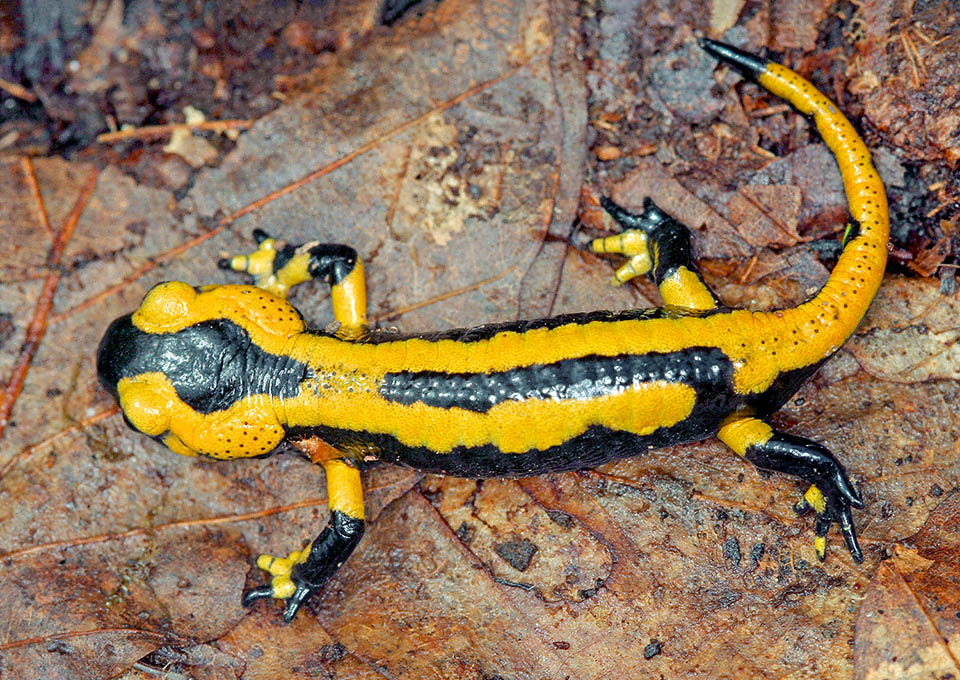
Due to the strong resemblance between the various subspecies to identify surely a specimen is often necessary the molecular analysis © Christian Hugues
This is one of the biggest subspecies of salamander. It has an imposing frame, long tail and well developed limbs with long toes. The background colour is black with small yellow spots scattered all over the body.
Salamandra salamandra morenica: is present from the southern boundary between Portugal and Spain up to the Sierra Morena, from which it gets the name. The build is broad with a dark colouration and scattered yellow and red spots, in particular in the region of the parotoid glands.
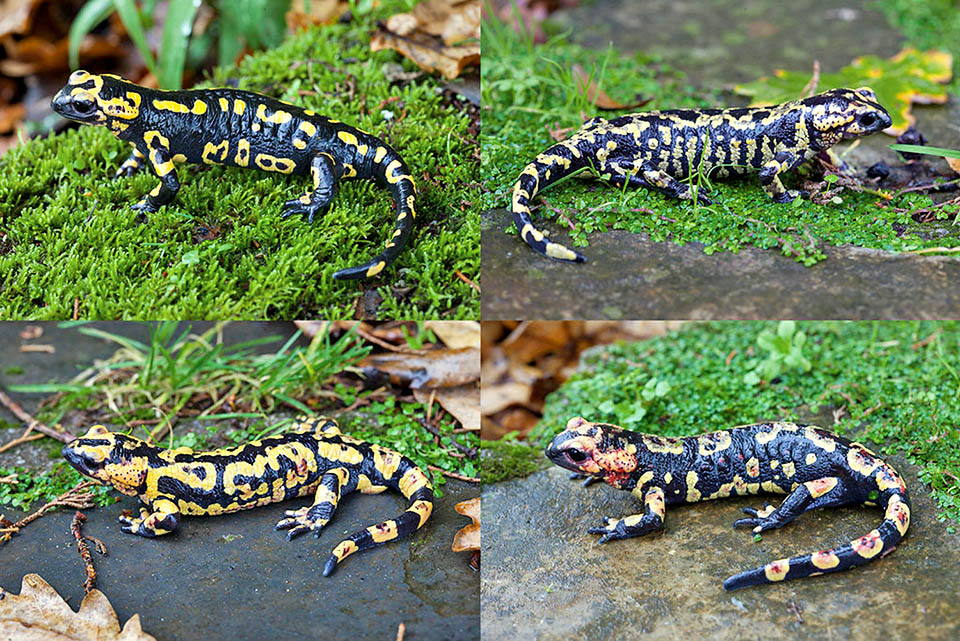
Salamandra salamandra gallaica variability, characterized by the presence of spots shaped like a comma or a horseshoe © Frank Deschando
Salamandra salamandra bernardezi : commonly called Oviedo fire salamander, this subspecies owes its vernacular name to the central location of its distribution range. Endemic to the northern belt of Spain, has a tiny body with a colouration that sees the presence of a longitudinal black band from the head to the tail. Some variations see the presence of other two black lines on the sides.
Salamandra salamandra bejarae: present in the central and oriental zones of the Meseta in Spain. It has a colouration mainly black with some small scattered irregular yellow spots and a slightly pointed snout.
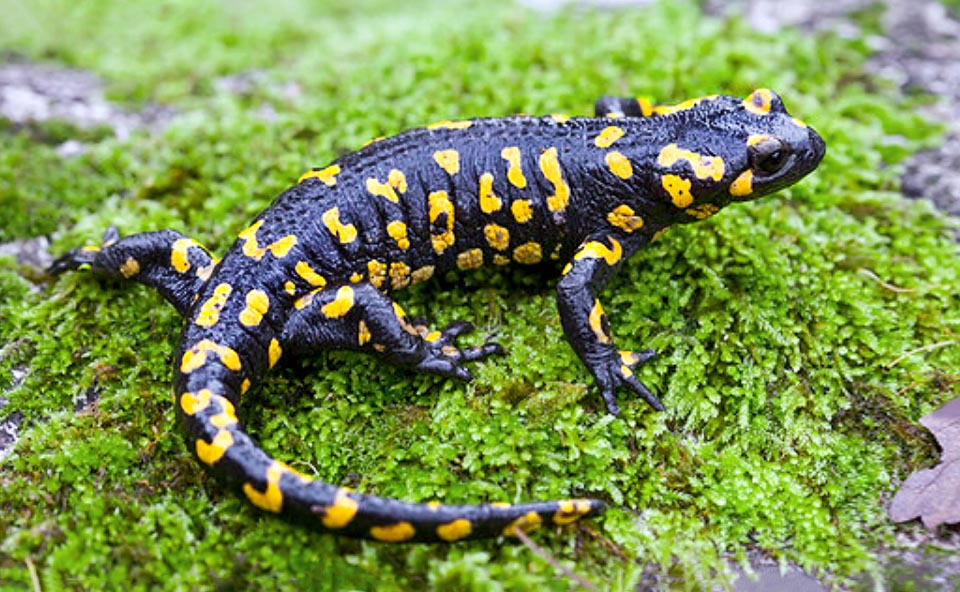
Salamandra salamandra crespoi distinguishes morphologically for its robust body, with long tail and big limbs © Frank Deschandol
Salamandra salamandra almanzoris: present in central Spain, we find it in the higher altitudes of the Sierra de Gredos and the Sierra de Guadarrama. Very similar to the Salamandra salamandra bejarae, it distinguishes from this mainly by genetic means. It has a small build and reduced dimensions if compared with the conspecifics, with a black colouration and yellow spots distributed all over the body.
Salamandra salamandra longirostris: subspecies endemic to southern Spain, particularly in Andalusia. Commonly called Long-snouted salamander, it has black body with quadrangular yellow spots, with pointed snout and grey belly.
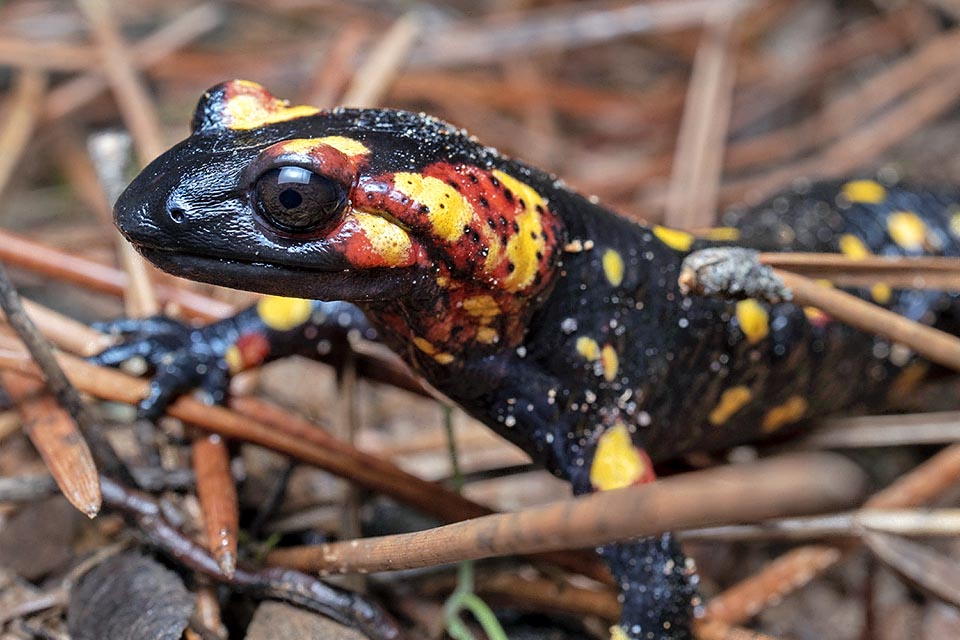
Salamandra salamandra morenica has red colourations concentrated mostly in the zone of the parotoid glands © Fernando Iglesias
Salamandra salamandra fastuosa: distributed in the Cantabrian Mountains and in the western and central Pyrenees, north-eastern Spain and southern belt of France at the boundary with Spain. It presents the characteristics of the species more evidenced: the bright yellow colour is distributed on all the body in two longitudinal bands well marked compared to the glossy black. The females of this subspecies sometimes may deliver young salamanders already metamorphosed.
Salamandra salamandra terrestris: with a distribution going from eastern Spain up to Germany, the pre-alpine salamander displays along the back some black streaks that may be more or less interrupted.
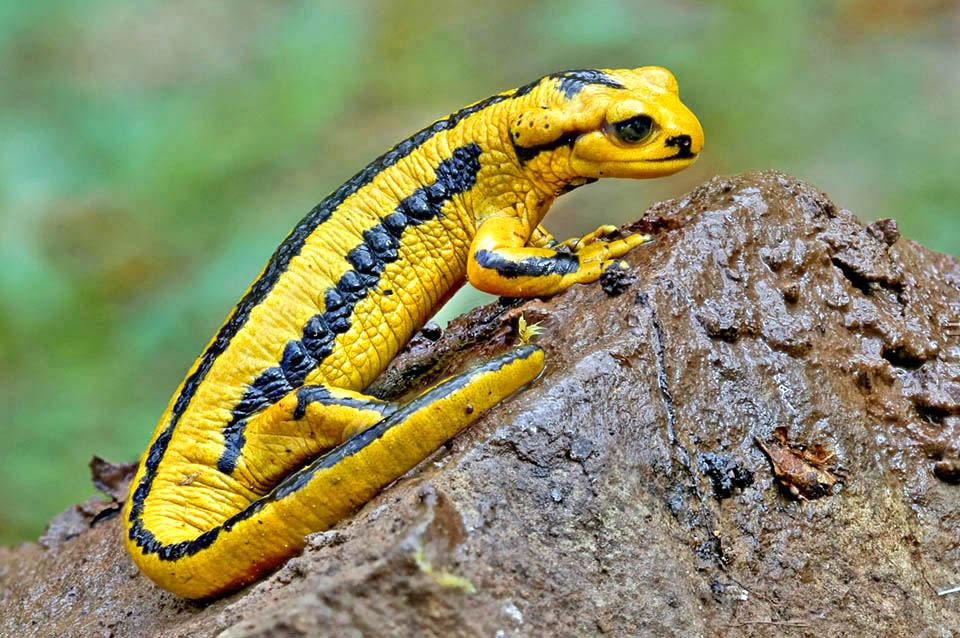
The Salamandra salamandra bernardezi, endemic to North Spain, is characterized by a long black dorsal band that goes from the head to the tail © Frank Hendre
Salamandra salamandra salamandra has a distribution from Italy up to central Europe and the Balkan Peninsula. In Italy it is present in the pre-alpine and alpine belt of the Ligurian Alps up to the Carnic Alps. It shows a colouration having a neat dominance of the black on the yellow. It has many yellow spots (at times orange or red) of different dimensions and shape, that at times may form some longitudinal streaks.
Salamandra salamandra gigliolii: subspecies endemic to the Appenninic Italy from Piedmont up to Calabria, with some populations strongly localized in Puglia. It has the dorsal region provided with yellow spots that often merge forming vermicular lines. The ventral region also presents some yellow and at times orange parts.
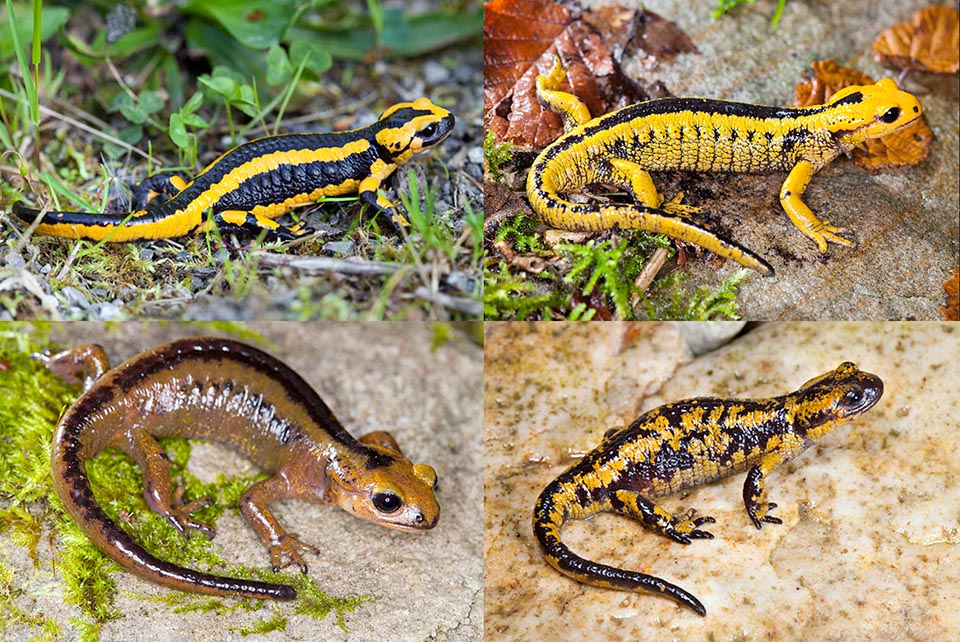
Four specimens compared of Salamandra salamandra bernardezi. It’s interesting to note that also when the individuals have different colours, they often keep the characteristics peculiar to their subspecies. In this case, for instance, they all show clearly the typical longitudinal black line on the back © Frank Deschandol
Salamandra salamandra werneri: present in the central and southern areas of Greece. It has many small irregular spots, sporadically with bright red centre, that sometimes can arrange themselves to form longitudinal lines.
Ecology-Habitat
Like most amphibians, the Fire salamander frequents various types of environments but can be found more frequently in the cool woods of broad-leaved trees having a humid litter and presence of water streams. It can be observed also in the Mediterranean maquis, mountain prairies and alpine horizon.
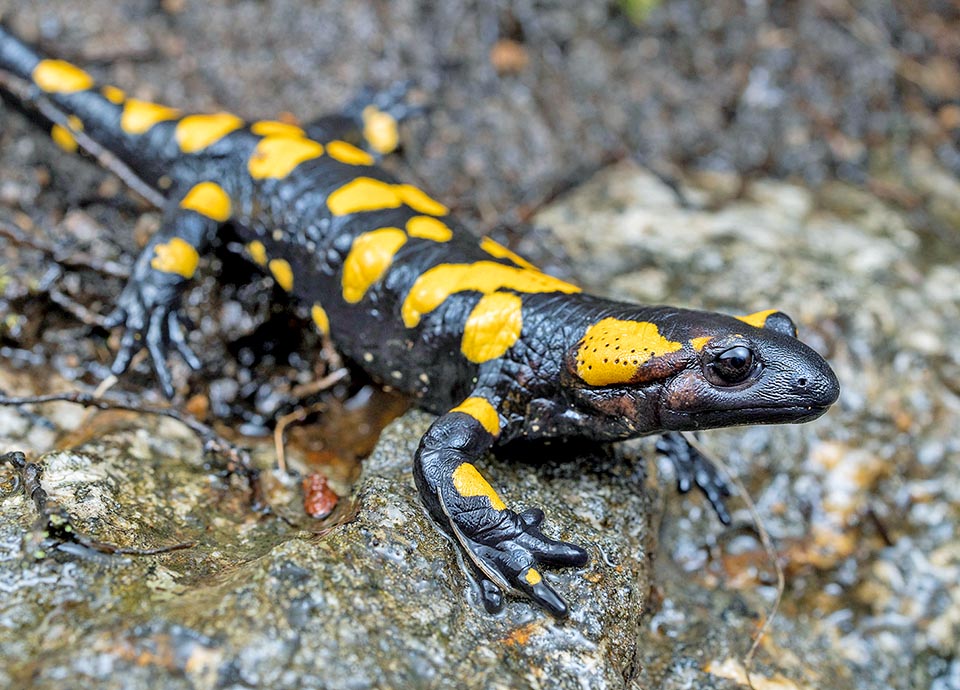
The Salamandra salamandra bejarae has a slightly flattened snout with a black colouration and yellow spots distributed on the body © Fernando Iglesias
During the winter period of hibernation, they can be active for short periods if the climate conditions allow it even if in spring and in autumn they are more active. Being an eurythermal species it is able to live in wide temperature terms It can be found starting from the sea level up to a maximum of 2350 m in the Pyrenees Mountains, even if its optimum stands between 200 and 1000 m.
The larvae can live in many types of aquatic environments that must satisfy the following necessities: shady zones, absence (or almost) of aquatic vegetation, clear and well oxygenated water, temperature between 10 and 20 °C.
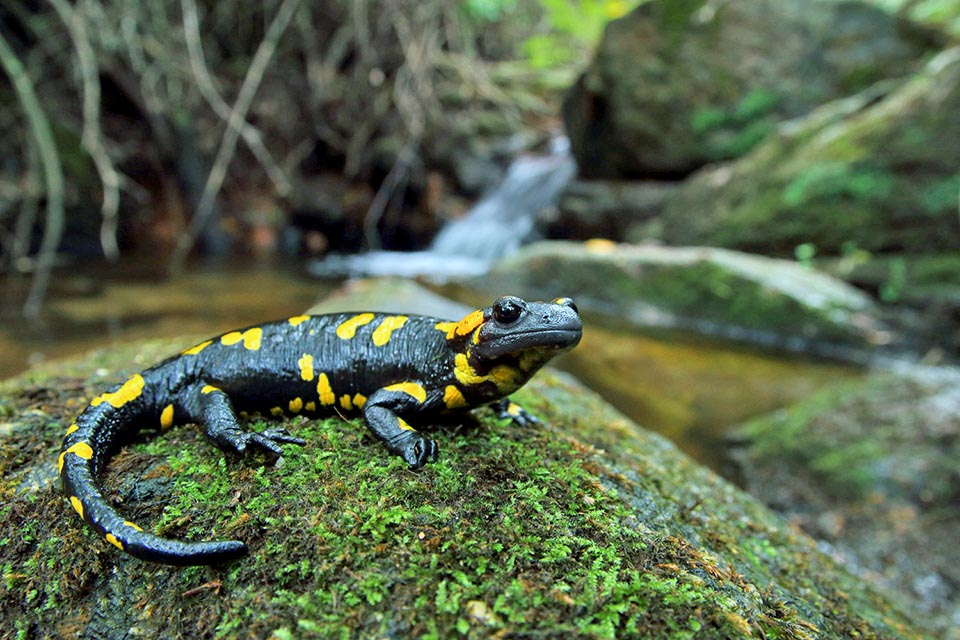
At times, if we do not know exactly to location of finding of a specimen, the only way to reach the identification is the analysis of the DNA. In this case, for instance, the suggestive Salamandra salamandra almanzoris here shown presents in fact a colouration very similar to Salamandra salamandra bejarae © Fernando Iglesias
Morphophysiology
The particularity of this species that goes up the most to the eye is surely the aposematism of the livery characterized by the glossy black and yellow colours.
The ventral side has a colour opaquer black or black with yellow insertions. The pattern of the dorsal design is not constant in the species and changes in the different populations as well as in the different individuals. Not rare are the cases of anomalies in the colouration, among the most frequent is the semi-albinism.
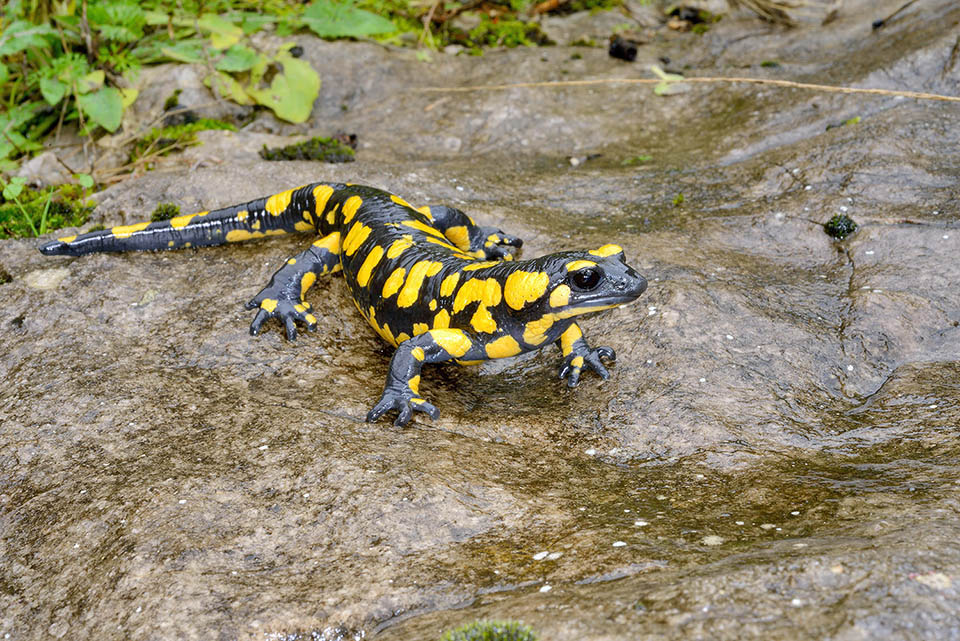
Tha Salamandra salamandra longirostris has a long body with a black colouration and quadrangular yellow spots. Pointed snout and grey belly © Sebastian Voitel
The Fire salamander has an overall look robust and stocky.
Unlike the other European salamanders, it has a developed tail with sub-circular section and slightly rounded apex. The tail is normally as long as the head plus the body.
The limbs are short but resistant and all toes are not palmate. The head is as big and long as broad with a prominent snout. The eyes are big with brown-dark or brown blackish iris. It has two parotoid glands, well developed, with the pores in evidence extending from behind the eye up to the neck.
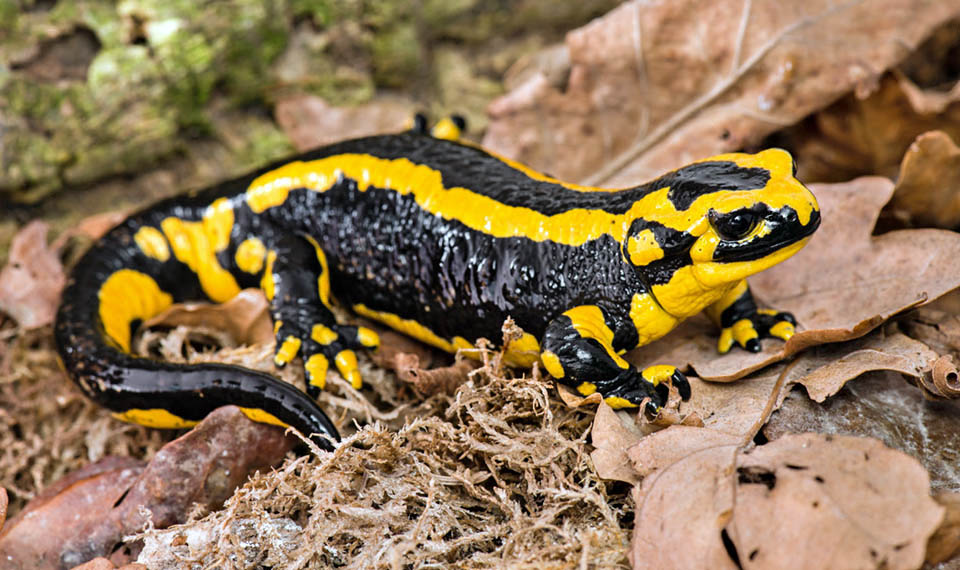
Conversely, Salamandra salamandra fastuosa shows two yellow bands along all the body in clear contrast with the dark colouration © John P Clare
The parotoid glands are formed by a masses of granular glands of which are seen the exit pores of the secretions. There are also two rows of glandular pores arranged longitudinally in the median zone of the back and of the tail.
Its dimensions are included between the 12 cm and the 20 cm, even if occasionally bigger individuals are observed.
It does not have a very marked sexual dimorphism. Usually, the male is leaner, but the most evident character is the region of the cloaca: in the male this is more swollen than that of the female where it is flatter.
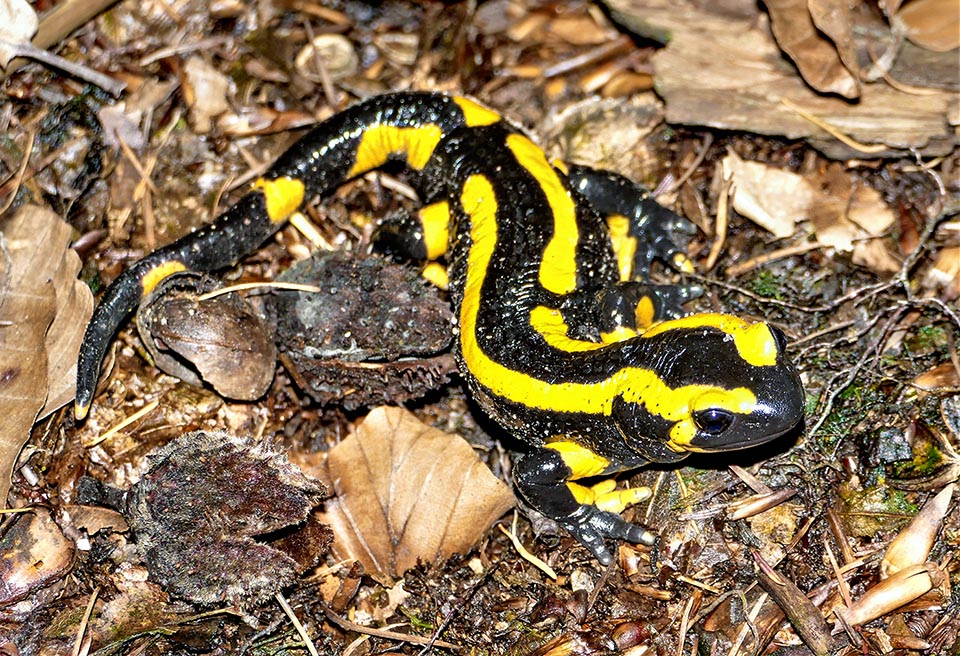
Salamandra salamandra terrestris shows some black lines that can be continuous or divided by yellow commas © Paul Bachhausen
The Fire salamander has an opportunistic diet. The larvae nourish of aquatic invertebrates such as Nematodes, small Crustaceans, Chilopods, larvae of Insects, Gastropods and Bivalves, at times larvae of Anurans.
Sporadically episodes of cannibalism occur towards smaller specimens in conditions of overpopulation and of shortage of prey.
The metamorphosed and the adults nourish only in the terrestrial environment and their preys are mainly arthropods like Insects and their larvae, Chilopods, Diplopods, Isopods, Spiders but also Gastropods and Oligochaetes. In adults the sense of smell covers a fundamental role in the search of prey.
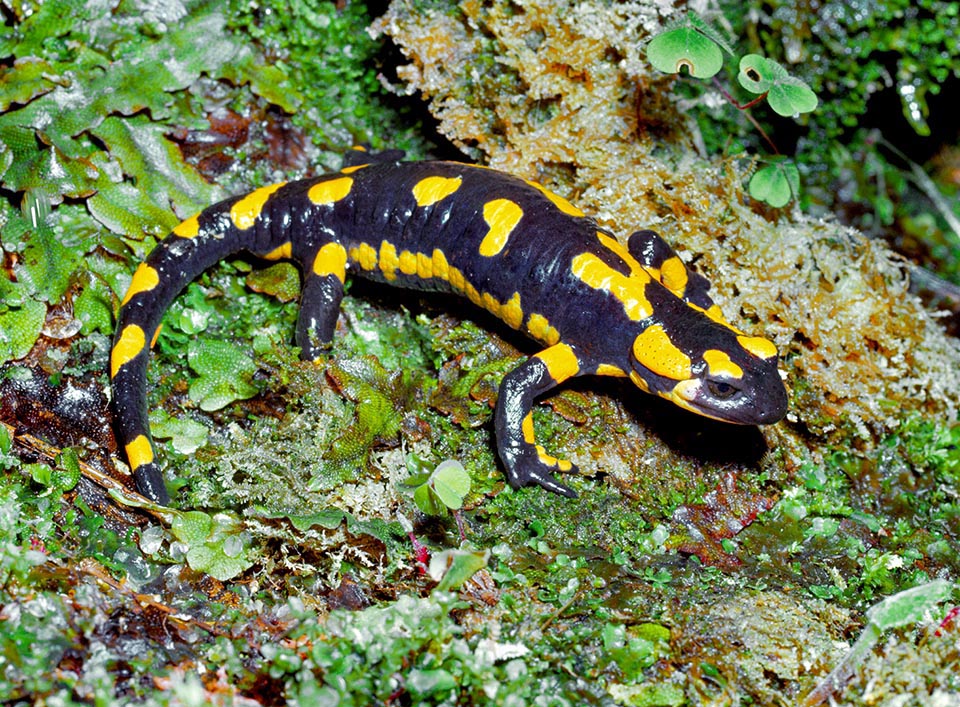
Salamandra salamandra salamandra has a black livery with yellow spots scattered on all its body that may assume different shapes © Giuseppe Mazza
The individuals in the larval stage are predated mainly by trouts and carnivorous fishes with whom they share the environment during their development stages. Moreover, they are eaten by the larvae of aquatic insects such as the Caddis flies, some aquatic birds and eventually by the Ringed snake (Natrix natrix).
The adult Fire salamander is an excellent example of aposematism. The aposematic colouration is characterized by a strong contrast of bright colours, in this case the black and the yellow or orange. This morphology is part of the defense mechanisms against the predators as it has a function of alarm and warning of toxicity. Rightly thanks to this colouration it has, the Fire salamander has few natural foes.
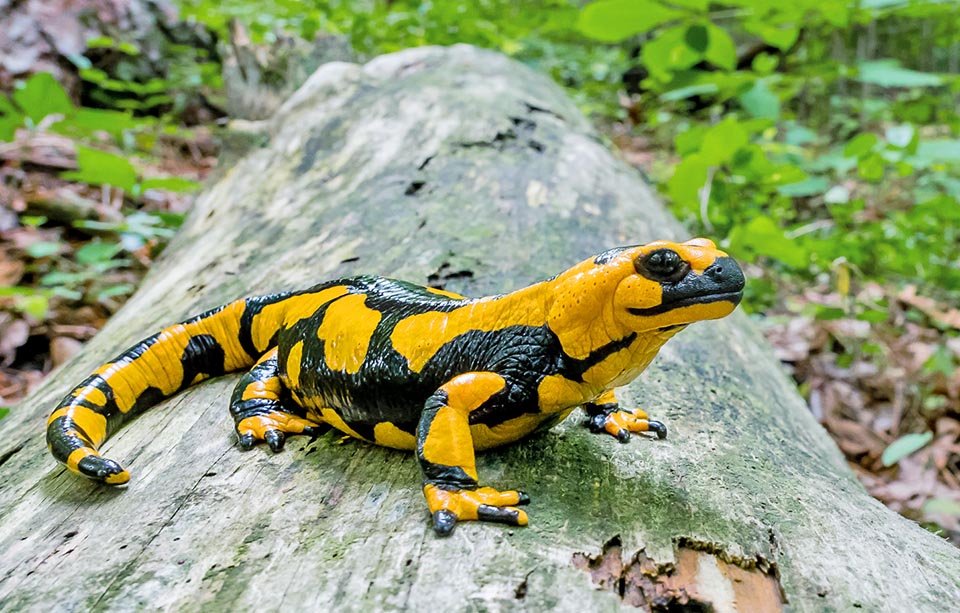
Endemic to the Italian territory, Salamandra salamandra gigliolii has a stocky build with a livery where the orange prevails over the yellow on the black body © John P Clare
A further protection against possible predators is furnished by the irritating property and the poisonous nature of its skin secretions released by the glands scattered along the body. Conversely, some major predators can feed on quietly of whole individuals without any harm due to their toxicity. This is the case of the Ringed snake, some carnivorous birds and the boar.
Ethology-Reproductive Biology
Salamandra salamandra is an ovoviviparous species, which means that its reproduction sees the incubation of the eggs inside the female and then the birth of the independent larvae, even if the females of some subspecies in some environmental conditions can deliver directly young salamanders already metamorphosed.
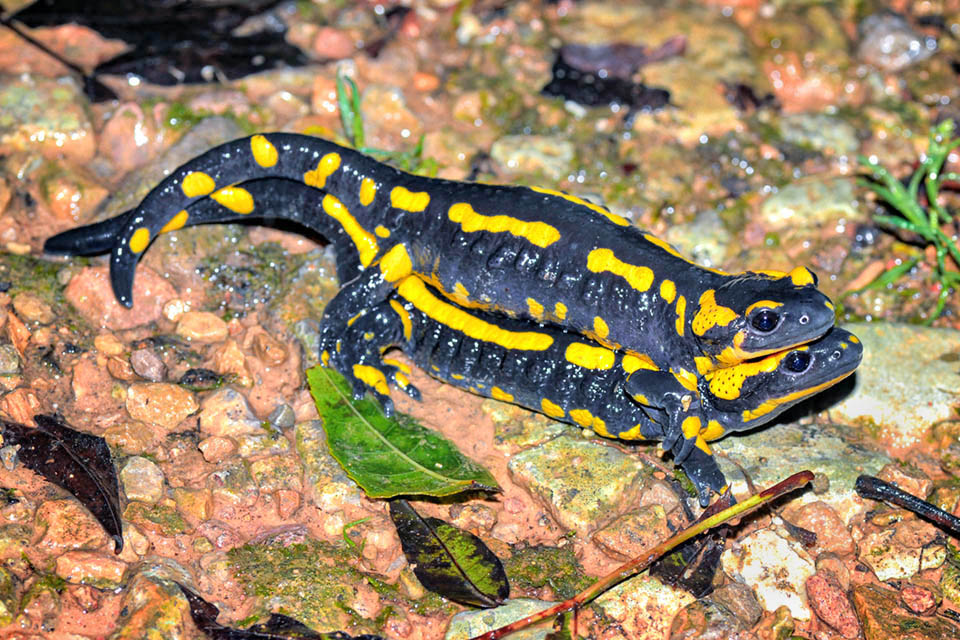
In mating preliminaries the male hugs the female and stimulates her head by rubbing it with the throat. Then lays on the soil a spermatophore collected from the partner © Alexandre Roux
The mating period is mainly the spring-summer but they may occur even in autumn.
The reproductive period is divided in 5 phases: the male heat moves actively, rises on the hind limbs and displays a dynamic buccopharyngeal breathing, with also an olfactory function to better locate the smell of the female.
Then it gets on the female and while embracing it strictly on the neck rubs its head with the throat.
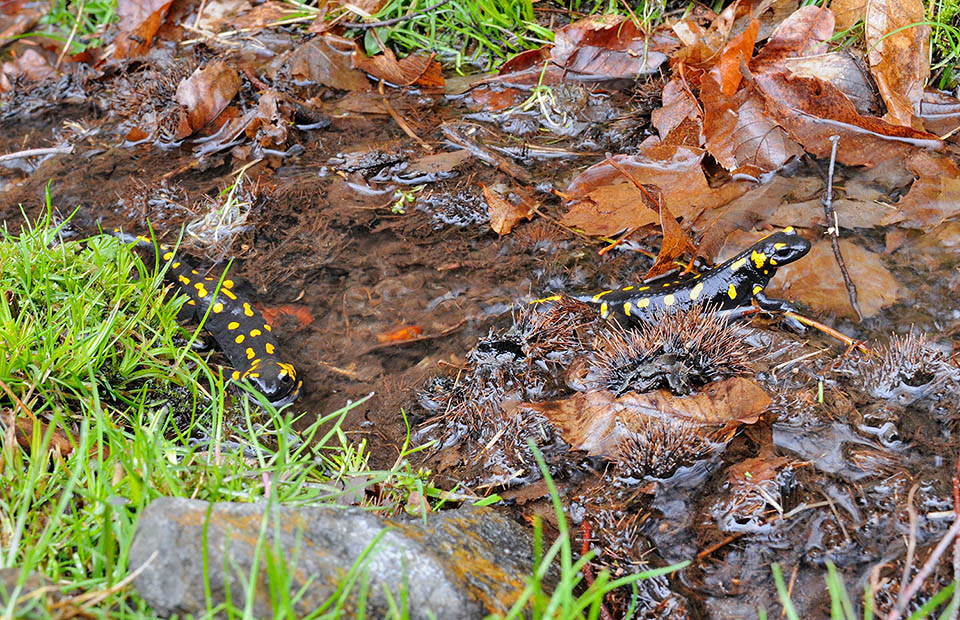
The adults of Salamandra salamandra abandon the water forever. Only the females, unable to swim, frequent it for the delivery © Grégoire Meier
It wedges itself under the female lifting with its head the fore limbs in order to slip under it while continuing to stimulate the head with the throat.
If the female does not manifest resistance, the male, with some windings of the tail stimulates the region of the cloaca and then ends up lying on the soil a spermatophore (a capsule enclosing the spermatozoa) moving to the side to allow the female to suck it in its cloaca. During the state of arousal and usually in the period of the matings the individuals can emit sounds that recall the squeaks of the murids.
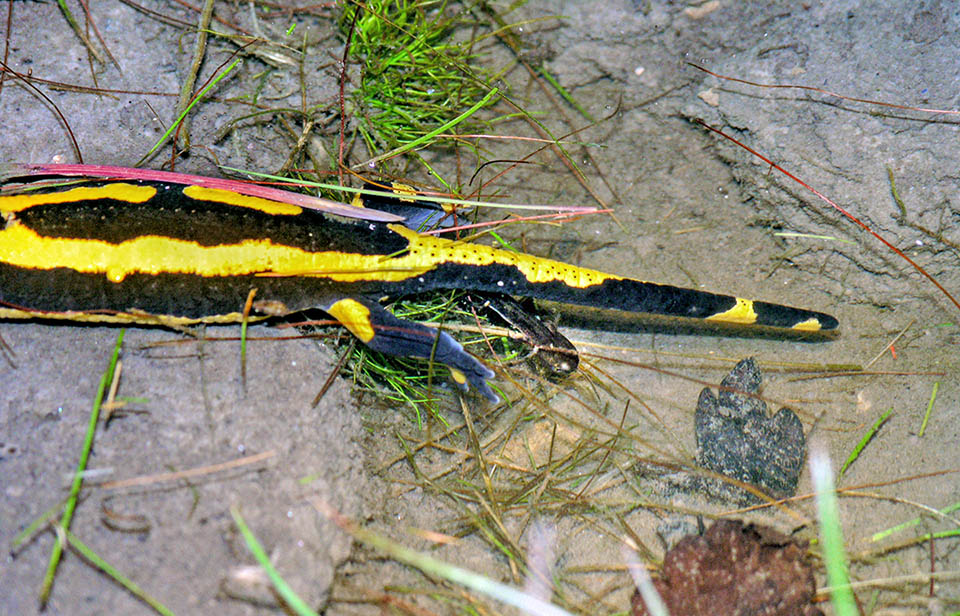
They release in the water, cautiously, moving back, 8-70 larvae keeping out the front of the body © Arnaud Jamin
The spermatozoa keep active up to one and a half year from the coupling.
The gestation lasts about one year and by the end the female delivers directly in running and very oxygenated waters 8-70 larvae.
At the time of birth, the larvae are 2-3 cm large and in 2-4 months (depending on the trophic availability and the environmental conditions) may reach the 7 cm before the metamorphosis.
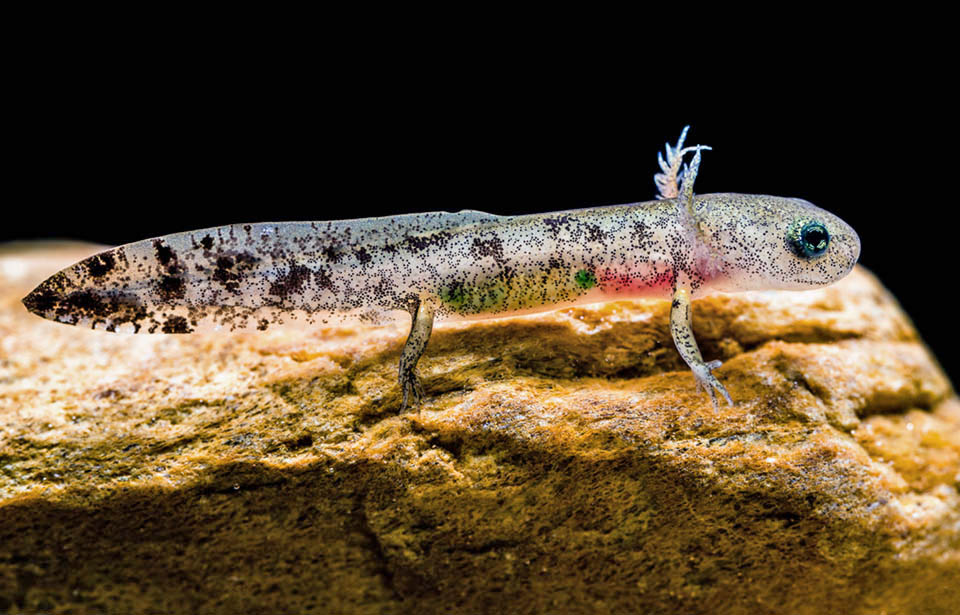
At birth they measure 2-3 cm. They have outer gills for breathing and the limbs sprout afterwards during the development © John P Clare
The larva has four functional limbs and external gills for breathing. Its median dorsal crest may extend from the tail up to mid-trunk and reduces progressively during the larval phase until it disappears from the back.
Initially brown-grey or brown-yellowish, the colouration of the larvae gets the characteristic yellow speckling on the back and on the tail as it gets closer to the moment of the metamorphosis. This process sees before the appearance of the forelimbs, then the hind ones and in the meantime is reabsorbed the caudal membrane. The last phase of the metamorphosis sees the atrophying of the gill tufts.
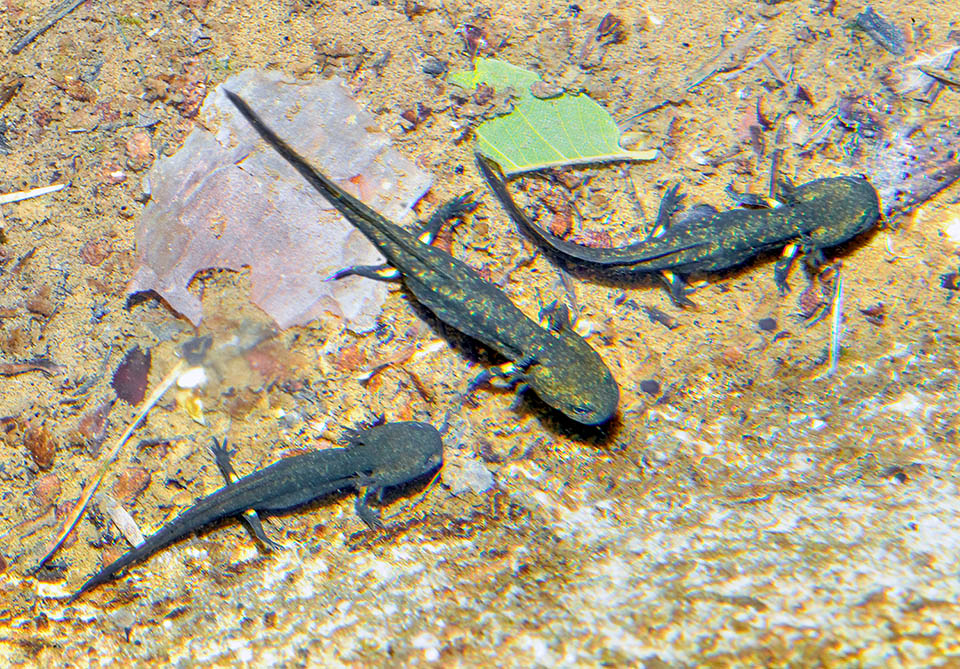
The tadpoles grow in clear waters, well oxygenated, with temperatures usually between 10 and 20 °C © Giuseppe Mazza
The period of the metamorphosis has a variable duration depending on the environmental and trophic conditions but usually takes 3 to 6 months.
The sexual maturity is achieved by both sexes when about 4 years old, in the mountain populations around the 5-6 years.
In nature Salamandra salamandra may reach without any problem the 20 years of life whilst in captivity has been observed a longevity of more than 43 years.
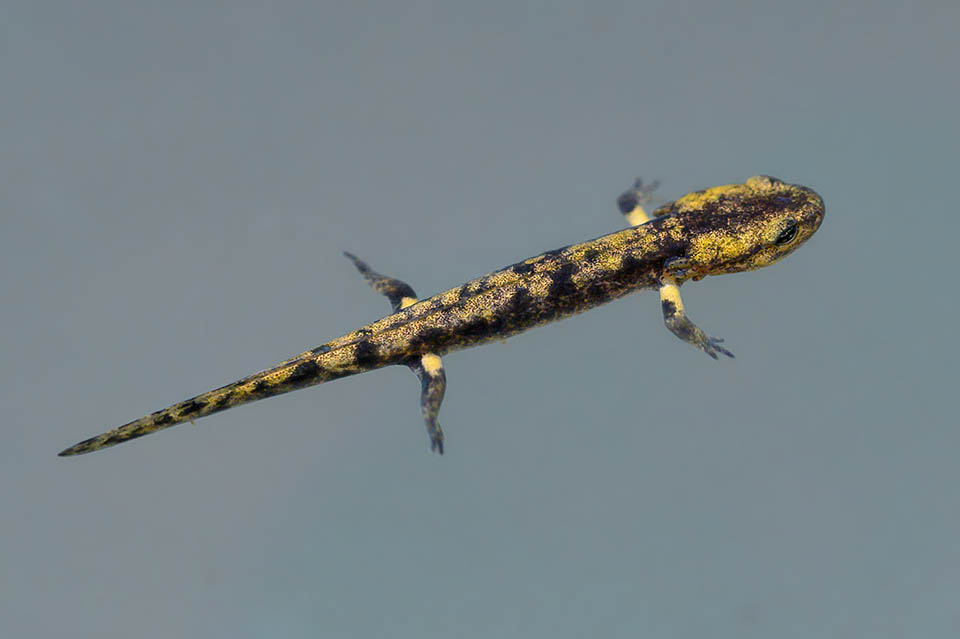
The characteristic yellow speckled colouration of the back and the tail appears when metamorphosis begins, when the gills are atrophied and the young swim to the surface © Noham Trigaud
Synonyms
Described the first time by Linaneus as Lacerta salamandra in 1758, this species has been assigned to the binomen Salamandra salamandra only in 1896 by Lönnberg.
Proteus tritonius Laurenti, 1768; Salamandra candida Laurenti, 1768; Salamandra maculosa Laurenti, 1768; Salamandra maculata Merrem, 1820.
→ For general notions about Caudata please click here.
→ To appreciate the biodiversity within the SALAMANDERS please click here.
